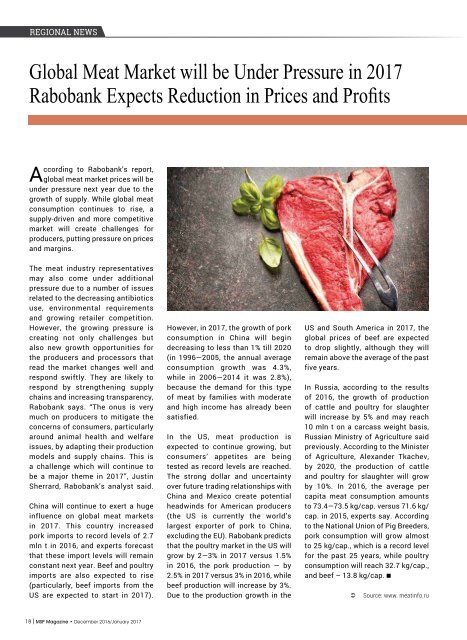MSP Issue 23
Create successful ePaper yourself
Turn your PDF publications into a flip-book with our unique Google optimized e-Paper software.
Regional News<br />
Global Meat Market will be Under Pressure in 2017<br />
Rabobank Expects Reduction in Prices and Profits<br />
According to Rabobank’s report,<br />
global meat market prices will be<br />
under pressure next year due to the<br />
growth of supply. While global meat<br />
consumption continues to rise, a<br />
supply-driven and more competitive<br />
market will create challenges for<br />
producers, putting pressure on prices<br />
and margins.<br />
The meat industry representatives<br />
may also come under additional<br />
pressure due to a number of issues<br />
related to the decreasing antibiotics<br />
use, environmental requirements<br />
and growing retailer competition.<br />
However, the growing pressure is<br />
creating not only challenges but<br />
also new growth opportunities for<br />
the producers and processors that<br />
read the market changes well and<br />
respond swiftly. They are likely to<br />
respond by strengthening supply<br />
chains and increasing transparency,<br />
Rabobank says. “The onus is very<br />
much on producers to mitigate the<br />
concerns of consumers, particularly<br />
around animal health and welfare<br />
issues, by adapting their production<br />
models and supply chains. This is<br />
a challenge which will continue to<br />
be a major theme in 2017”, Justin<br />
Sherrard, Rabobank’s analyst said.<br />
China will continue to exert a huge<br />
influence on global meat markets<br />
in 2017. This country increased<br />
pork imports to record levels of 2.7<br />
mln t in 2016, and experts forecast<br />
that these import levels will remain<br />
constant next year. Beef and poultry<br />
imports are also expected to rise<br />
(particularly, beef imports from the<br />
US are expected to start in 2017).<br />
However, in 2017, the growth of pork<br />
consumption in China will begin<br />
decreasing to less than 1% till 2020<br />
(in 1996—2005, the annual average<br />
consumption growth was 4.3%,<br />
while in 2006—2014 it was 2.8%),<br />
because the demand for this type<br />
of meat by families with moderate<br />
and high income has already been<br />
satisfied.<br />
In the US, meat production is<br />
expected to continue growing, but<br />
consumers’ appetites are being<br />
tested as record levels are reached.<br />
The strong dollar and uncertainty<br />
over future trading relationships with<br />
China and Mexico create potential<br />
headwinds for American producers<br />
(the US is currently the world’s<br />
largest exporter of pork to China,<br />
excluding the EU). Rabobank predicts<br />
that the poultry market in the US will<br />
grow by 2—3% in 2017 versus 1.5%<br />
in 2016, the pork production — by<br />
2.5% in 2017 versus 3% in 2016, while<br />
beef production will increase by 3%.<br />
Due to the production growth in the<br />
US and South America in 2017, the<br />
global prices of beef are expected<br />
to drop slightly, although they will<br />
remain above the average of the past<br />
five years.<br />
In Russia, according to the results<br />
of 2016, the growth of production<br />
of cattle and poultry for slaughter<br />
will increase by 5% and may reach<br />
10 mln t on a carcass weight basis,<br />
Russian Ministry of Agriculture said<br />
previously. According to the Minister<br />
of Agriculture, Alexander Tkachev,<br />
by 2020, the production of cattle<br />
and poultry for slaughter will grow<br />
by 10%. In 2016, the average per<br />
capita meat consumption amounts<br />
to 73.4—73.5 kg/cap. versus 71.6 kg/<br />
cap. in 2015, experts say. According<br />
to the National Union of Pig Breeders,<br />
pork consumption will grow almost<br />
to 25 kg/cap., which is a record level<br />
for the past 25 years, while poultry<br />
consumption will reach 32.7 kg/cap.,<br />
and beef – 13.8 kg/cap.<br />
Â<br />
Source: www. meatinfo.ru<br />
18 | <strong>MSP</strong> Magazine • December 2016/January 2017

















